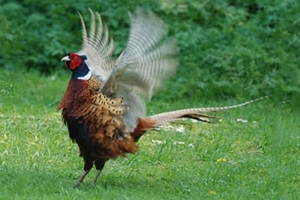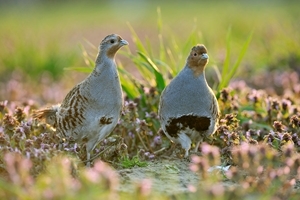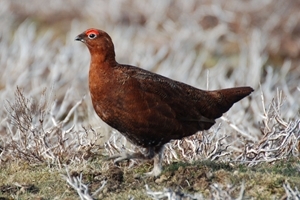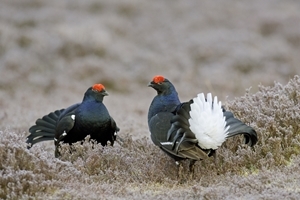Pheasant
 The male pheasant is particularly well-known for its beautiful, golden-coloured feathers, green head, red wattle or comb above the eye, and, of course, its long tail and distinctive strut. The hen birds are more grey/brown with a shorter tail. They live in woodland and farmland across the UK eating seeds, shoots and insects. Resident in Britain since before the 15th Century, they became an important gamebird in the 20th Century.
The male pheasant is particularly well-known for its beautiful, golden-coloured feathers, green head, red wattle or comb above the eye, and, of course, its long tail and distinctive strut. The hen birds are more grey/brown with a shorter tail. They live in woodland and farmland across the UK eating seeds, shoots and insects. Resident in Britain since before the 15th Century, they became an important gamebird in the 20th Century.
Grey partridge
 The grey partridge can be found on the ground in groups or coveys of 6-10, but separate out into pairs in the spring. They have very distinctive dark orange faces with a dark, horseshoe-shaped patch on their tummy. They feed on seeds, leaves and small insects.
The grey partridge can be found on the ground in groups or coveys of 6-10, but separate out into pairs in the spring. They have very distinctive dark orange faces with a dark, horseshoe-shaped patch on their tummy. They feed on seeds, leaves and small insects.
The grey partridge is a much-loved gamebird, arriving naturally in the UK after the last ice age. Their numbers are now suffering due to a change in farming methods such as the use of herbicides to kill weeds, leaving less food for insects, the grey partridge chicks’ main source of food, to feed off. Less predator control was also carried out, meaning nests were raided and chicks eaten by the likes of stoat and crows. In addition, the removal of hedgerows to make bigger fields and aid efficient farming reduced the cover and protection offered to the grey partridge, leaving fewer places for them to hide from predators. Being ground-nesting birds, they don’t have an easy time as they become very easy targets for predators. As a result, grey partridge are now on the RSPB Red list.
Photo credit: Rollin Verlinde
Red grouse
 The red grouse is a warm, golden-brown colour, with their distinctive red wattle or comb above the eye. They are found in heather moorland, including blanket bog and upland shrub heath, all year round. Their diet is almost exclusively heather. Moorland is often managed by keepers for grouse, but you can only provide a habitat; you can’t rear grouse from eggs and chicks. Grouse nest on the ground in amongst the heather; they are therefore easy targets for predators such as the stoat and weasel. They are also a delicacy to the golden eagle and other raptors that live in the moorland.
The red grouse is a warm, golden-brown colour, with their distinctive red wattle or comb above the eye. They are found in heather moorland, including blanket bog and upland shrub heath, all year round. Their diet is almost exclusively heather. Moorland is often managed by keepers for grouse, but you can only provide a habitat; you can’t rear grouse from eggs and chicks. Grouse nest on the ground in amongst the heather; they are therefore easy targets for predators such as the stoat and weasel. They are also a delicacy to the golden eagle and other raptors that live in the moorland.
Black grouse
 The male black grouse is a deep blue/black colour with a very distinctive red wattle over its eyes. The female is brown in colour. They are particularly known for their mating ritual known as lekking, during which the males in groups will strut around, flaring out their white tail, trying to attract the females who are watching on from the surrounding area. In May they lay 6-11 eggs in a grassy scrape on the ground. Living in the uplands on moorland and grasslands, their diet consists of heather, bilberries and invertebrates.
The male black grouse is a deep blue/black colour with a very distinctive red wattle over its eyes. The female is brown in colour. They are particularly known for their mating ritual known as lekking, during which the males in groups will strut around, flaring out their white tail, trying to attract the females who are watching on from the surrounding area. In May they lay 6-11 eggs in a grassy scrape on the ground. Living in the uplands on moorland and grasslands, their diet consists of heather, bilberries and invertebrates.